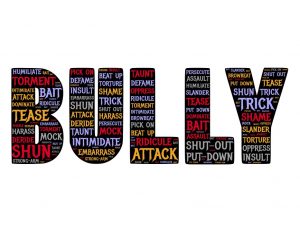How would you describe bullying? Has your child been bullied? Have you? When I taught a workshop at the California Association for the Education of Young Children (CAEYC) in Pasadena for adults working with children in the primary grades. 
Over 50 educators actively participated in my workshop: Bullying 101: Helping the Bully, the Bullied, and the Bystander: How Educators Can Help Break the Cycle of Violence.
The two months I spent preparing for this workshop were emotionally challenging. It was difficult to read books, research, and view videos about what’s happening on elementary campuses. As I read about bullying definitions, I often thought of the squabbles I observe weekly between five-year olds.
When a peer doesn’t do what their friend wants, I hear, “You’re not going to be my friend anymore,” or, “You’re not invited to my birthday party.” If they are really upset, they might say both sentences together. So is this bullying?
Bullying Definition
Although there are numerous bullying definitions, I chose this one because it contains multiple aspects. Three criteria distinguish bullying from other misbehaviors or isolated cases of aggression.
1. “It is aggressive behavior or intentional harm doing.
2. It is carried out repeatedly and over time.
3. It occurs within an interpersonal relationship characterized by an imbalance of power.” 1, p. 232
Are the squabbling five-year olds bullying?
Their behavior is not always aggressive but they are saying these things to express frustration. Most likely, it is the meanest thing they know so say. The words are intentional, although very short lived. Later, they are once again friends and get re-invited to the party.
Yes, it is carried out repeatedly over time, but by different children. It isn’t only one or two children who make these threats against certain children. It seems to be a regular part of their interactions as they learn more appropriate social skills. Is it acceptable? To me, it is not. I’d like the teacher to intervene and explain how that hurts others’ feelings and how to state their frustration in a more specific way. “I don’t like it when you take my cars.”
Finally, is there an imbalance in power? An imbalance of power could be by size, age, or abilities. Although the children are all different, I don’t observe an imbalance of power. In this situation, I’d say that the children are not bullying, but learning how to express themselves; however, they need more adult guidance. What do you think? Are the children being bullied?
Source:
1. Hirsch, Lee & Lowen, Cynthia with Santorelli, Dina (Editors). Bully: An Action Plan for Teachers, Parents, and Communities to Combat the Bullying Crisis. [Companion to the Acclaimed Film Bully] New York: Weinstein Books, 2012, p. 232.
2. Image Source: bully-oppression [Pixabay.com]

Thanks for being a part of battling this huge problem Dr Fritzemeier. Our schools need all the help they can get
Thanks for being a part of battling this huge problem Dr Fritzemeier. Our schools need all the help they can get